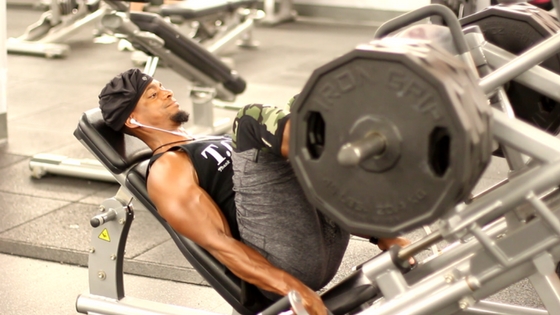With each exercise, you’d do a given amount of repetitions (reps) and you do that amount of reps for a given amount of sets. For example if you’re doing bicep curls, you could be doing 3 sets of 10 reps, or 3×10. If that sounds confusing for you, think of it as 30 reps divided into 3 sets.
When considering how many sets and reps to do in your training routine you have to consider a variety of different aspects.
- What is your training goal?
- What muscle fibers are you targeting?
- How much time do you have to train?
- How much training volume do I need?

Sets & Reps For Muscle Building
In order to effectively increase muscle mass, you need to maximize tension and muscle fiber recruitment during each exercise. There are a few options for getting this done, but in regards to sets and reps there’s 2 options.
- Use a heavy load with less reps.
- Use a moderate to light load with more reps.
The heavier loads will increase your strength and target your type 2 muscle fibers, which have the greatest potential for size development. Ideally the heavy lifting should come at the beginning of your training session. Lifting heavy after already being fatigued will limit training performance in these big lifts, thus limiting the results.
The moderate to lighter loads will target your type 1 muscle fibers. Training these muscle fibers will increase muscular endurance, blood flow, and improve stability. These lifts are secondary to your heavier lifts being that they perform better under sustained fatigue. An added bonus to training these muscle fibers is the drastically increased blood flow to the muscle that creates “the pump”.
Effectively training both muscle fiber types in the most strategic way will really maximize muscle growth as well as improve strength and performance. Here’s a quick example of what this looks like.
PRIMARY EXERCISES
8 Reps
6 Reps
4 Reps
SECONDARY EXERCISES
20 Reps
16 Reps
12 Reps
Optimal Rep Ranges For Muscle Building
The most common method used for building muscle is choosing a specific number of reps for each set. An example of this would be 1st set for 10 reps, 2nd for set 8 reps, 3rd set for 6 reps. This can work, but a major problem here is that rigidly sticking to the amount reps can cause you to leave a lot of training intensity on the table. Let’s say the goal is 8 reps, but you’re able to squeeze out 12 reps, did you maximize training intensity on that set if you stopped at 8? Did you maximize muscle tension?
If training intensity and maximal muscle tension is what creates the results we want, then the reps should facilitate the focus, not BE the focus. This is why rep ranges are ideal. An example of this would be 3 sets where each set has a rep range of 10-6. Start with a weight that you know you can get a maximum of 10 reps with. Increase the weight on each set and do as many reps as possible (AMRAP) in each set.
Both increasing the weight on each set and striving for the maximum amount of reps each set will allow you to get the most out of every workout. When you put everything together in a full training routine, this is what it look like.
1ST TRAINING DAY
Barbell Squat
3 Sets x 8-4 Reps (AMRAP)
Barbell Deadlift
3 Sets x 8-4 Reps (AMRAP)
Barbell Hip Bridge
3 Sets x 8-4 Reps (AMRAP)
Dumbbell Walking Lunge
3 Sets x 20-12 Reps (AMRAP)
2nd Training Day
Barbell Overhead Press
3 Sets x 8-4 Reps (AMRAP)
Barbell Bench Press
3 Sets x 8-4 Reps (AMRAP)
Dumbbell Incline Press
3 Sets x 20-12 Reps (AMRAP)
Dumbbell Lateral Raise
3 Sets x 20-12 Reps (AMRAP)
3rd Training Day
Barbell Row
3 Sets x 8-4 (AMRAP)
Weighted Pull Up
3 Sets x 8-4 (AMRAP)
Barbell Pull Over
3 Sets x 20-12 Reps (AMRAP)
Dumbbell Reverse Fly
3 Sets x 20-12 Reps (AMRAP)
*NOTE
This just serves as one example of this rep scheme idea just to give you a visual of what it looks like. This is a great setup to follow, but there are many others that also work really.
Tribe By Noire

I’ve created this platform to help you become the most powerful version of yourself through fitness, plant based nutrition, and mindset coaching.
copyright © 2018 Tribe By Noire. All Rights Reserved
